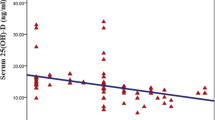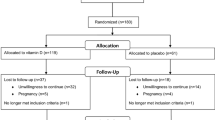Abstract
Insulin resistance (IR) is one of the common features of the polycystic ovary syndrome (PCOS), and recent studies indicate the possible role of vitamin D in the pathogenesis of IR and glucose metabolism. Aim of this study was aimed to determine the effect of vitamin D replacement therapy on glucose metabolism, insulin, and androgen levels in obese, insulin-resistant women with PCOS. Eleven women with PCOS were included in the study. Mean age of the patients was 23.6±5.7 yr, body mass index 33.9±5.1 kg/m2. Six patients (54.5%) had acantosis nigricans and 10 (90.9%) oligoamenorrhea. The mean Ferriman Gallwey score was 14.1 ±4.6. Only 2 women were within the normal limits of vitamin D levels as >20 ng/ml. Three weeks after the administration of the single dose of 300,000 units of vitamin D3 orally, 25-hydroxyvitamin D3 significantly increased from 16.9±16 ng/ml to 37.1 ±14.6 ng/ml (p: 0.027) and only 2 women were detected to have vitamin D3 levels <20 ng/ml. Although glucose and insulin levels were decreased non-significantly, homeostasis model assesment (HOMA)-IR significantly decreased from 4.41 ±1.38 to 3.67±1.48 (p: 0.043). No significant alterations were witnessed at the levels of DHEAS, total and free testosterone, androstenedione. No correlation was found between vitamin D with HOMA and other hormonal parameters. In conclusion, women with PCOS have mostly insufficient vitamin D levels, and vitamin D replacement therapy may have a benefical effect on IR in obese women with PCOS.
Similar content being viewed by others
References
Azziz R, Woods KS, Reyna R, Key TJ, Knochenhauer ES, Yildiz BO. The prevalence and features of the polycystic ovary syndrome in an unselected population. J Clin Endocrinol Metab 2004, 89: 2745–9.
Morin-Papunen LC, Vauhkonen I, Koivunen RM, Ruokonen A, Tapanainen JS. Insulin sensitivity, insulin secretion, and metabolic and hormonal parameters in healthy women and women with polycystic ovarian syndrome. Hum Reprod 2000, 15: 1266–74.
Diamanti-Kandarakis E, Dunaif A. New perspectives in polycystic ovary syndrome. Trends Endocrinol Metab 1996, 7: 267–1.
Galluzzo A, Amato MC, Giordano C. Insulin resistance and polycystic ovary syndrome. Nutr Metab Cardiovasc Dis 2008, 18: 511–8.
Yildiz BO, Yarali H, Oguz H, Bayraktar M. Glucose intolerance, insulin resistance, and hyperandrogenemia in first degree relatives of women with polycystic ovary syndrome. J Clin Endocrinol Metab 2003, 88: 2031–6.
Shoback D, Sellmeyer D, Bikle DD. Metabolic bone disease. In: Gardner DG, Shoback D eds. Greenspan’s Basic and Clinical Endocrinology. 8nd ed. New York: McGraw-Hill. 2007, 281–345.
Chiu KC, Chu A, Go VL, Saad MF. Hypovitaminosis D is associated with insulin resistance and beta cell dysfunction. Am J Clin Nutr 2004, 79: 820–5.
Borissova AM, Tankova T, Kirilov G, Dakovska L, Kovacheva R. The effect of vitamin D3 on insulin secretion and peripheral insulin sensitivity in type 2 diabetic patients. Int J Clin Pract 2003, 57: 258–61.
Isaia G, Giorgino R, Adami S. High prevalence of hypovitaminosis D in female type 2 diabetic population. Diabetes Care 2001, 24: 1496.
Maghbooli Z, Hossein-Nezhad A, Karimi F, Shafaei AR, Larijani B. Correlation between vitamin D3 deficiency and insulin resistance in pregnancy. Diabetes Metab Res Rev 2008, 24: 27–32.
Hahn S, Haselhorst U, Tan S, et al. Low serum 25-hydroxyvitamin D concentrations are associated with insulin resistance and obesity in women with polycystic ovary syndrome. Exp Clin Endocrinol Diabetes 2006, 114: 577–83.
Kotsa K, Yavropoulou MP, Anastasiou O, Yovos JG. Role of vitamin D treatment in glucose metabolism in polycystic ovary syndrome. Fertil Steril 2009, 92: 1053–8.
Rotterdam ESHRE/ASRM-Sponsored PCOS consensus workshop group. Revised 2003 consensus on diagnostic criteria and long-term health risks related to polycystic ovary syndrome (PCOS). Hum Reprod 2004, 19: 41–7.
Matthews D, Hosker J, Rudenski A, Naylor B, Treacher D, Turner R. Homeostasis model assesment: insulin resistance and beta-cell function from fasting plasma glucose and insulin concentrations in man. Diabetologia 1985, 28: 412–9.
Basaran S, Guzel R, Coskun-Benlidayi I, Guler-Uysal F. Vitamin D status: effects on quality of life in osteoporosis among Turkish women. Qual Life Res 2007, 16: 1491–9.
Olmez D, Bober E, Buyukgebiz A, Cimrin D. The frequency of vitamin D insufficiency in healthy female adolescents. Acta Pediatrica 2006, 95: 1266–9.
Tai K, Need AG, Horowitz M, Chapman IM. Vitamin D, glucose, insulin, and insulin sensitivity. Nutrition 2008, 24: 279–85.
Alemzadeh R, Kichler J, Babar G, Calhoun M. Hypovitaminosis D in obese children and adolescents: relationship with adiposity, insulin sensitivity, ethnicity, and season. Metabolism 2008, 57: 183–91.
Ehrmann DA, Schwarz PE, Hara M, et al. Relationship of calpain-10 genotype to phenotypic features of polycystic ovary syndrome. J Clin Endocrinol Metab 2002, 87: 1669–73.
Simpson RU, Thomas GA, Arnold AJ. Identification of 1,25-dihydroxyvitamin D3 receptors and activities in muscle. J Biol Chem 1985, 260: 8882–91.
Ishida H, Norman AW. Demonstration of a high affinity receptor for 1.25dihyroxyvitamin D3 in rat pancreas. Mol Cell Endocrinol 1988, 60: 109–17.
Uitterlinden AG, Fang Y, van Meurs JB, van Leeuwen H, Pols HA. Vitamin D receptor gene polymorphisms in relation to vitamin D related disease states. J Steroid Biochem Mol Biol 2004, 89-90: 187–93.
Palomer X, Gonzalez-Clemente JM, Blanco-Vaca F, Mauricio D. Role of vitamin D in the pathogenesis of type 2 diabetes mellitus. Diabetes Obes Metab 2008, 10: 185–97.
Baier LJ, Dobberfuhl AM, Pratley RE, Hanson RL, Bogardus C. Variations in the vitamin D-binding protein (Gc locus) are associated with oral glucose tolerance in nondiabetic Pima Indians. J Clin Endocrinol Metab 1998, 83: 2993–6.
Cade C, Norman AW. Rapid normalization/stimulation by 1,25-dihydroxyvitamin D3 of insulin secretion and glucose tolerance in the vitamin D deficient rat. Endocrinology 1987, 120: 1490–7.
Beaulieu C, Kestekian R, Havrankova J, Gascon-Barré M. Calcium is essential in normalizing intolerance to glucose that accompanies vitamin D depletion in vivo. Diabetes 1993, 42: 35–43.
Chiu KC, Chuang LM, Lee NP, et al. Insulin sensitiviy is inversely correlated with plasma intact parathyroid hormone level. Metabolism 2000, 49: 1501–5.
Huang Y, Ishizuka T, Miura A, et al. Effect of 1 alpha, 25-dihydroxy vitamin D3 and vitamin E on insulin-induced glucose uptake in rat adipocytes. Diabetes Res Clin Pract 2002, 55: 175–83.
Taylor AV, Wise PH. Vitamin D replacement in Asians with diabetes may increase insulin resistance. Postgrad Med J 1998, 74: 365–6.
Lind L, Pollare T, Hvarfner A, Lithell H, Sorensen OH, Ljunghall S. Long-term treatment with active vitamin D (alphacalcidol) in middle-aged men with impaired glucose tolerance. Effects on insulin secretion and sensitivity, glucose tolerance and blood pressure. Diabetes Res 1989, 11: 141–7.
Ortlepp JR, Lauscher J, Hoffmann R, Hanrath P, Joost HG. The vitamin D receptor gene variant is associated with the prevalence of type 2 diabetes mellitus and coronary artery disease. Diab Med 2001, 18: 842–5.
Thys-Jacobs S, Donovan D, Papadopoulos A, Sarrel P, Bilezikian JP. Vitamin D and calcium dysregulation in the polycystic ovarian syndrome. Steroids 1999, 64: 430–5.
Dunaif A. Insulin resistance and the polycystic ovary syndrome: Mechanism and implications for pathogenesis. Endocr Rev 1997, 18: 774–800.
Nestler JE, Jakubowicz DJ. Decreases in ovarian cytochrome P450c17alpha activity and serum free testosterone after reduction of insulin secretion in polycystic ovary syndrome. N Eng J Med 1996, 335: 617–23.
Plymate SR, Matej LA, Jones RE, Friedl KE. Inhibition of sex hormone-binding globulin production in human hepatoma (Hep G2) cell line by insulin and prolactin. J Clin Endocrinol Metab 1988, 67: 460–4.
Pasquali R, Gambineri A, Biscotti D, et al. Effect of long-term treatment with metformin added to hypocaloric diet on body composition, fat distribution, and androgen and insulin levels in abdominally obese women with and without the polycystic ovary syndrome. J Clin Endocrinol Metab 2000, 85: 2767–74.
Nestler JE, Barlascini CO, Matt DW, Steingold KA, Plymate SR, Clore JN, et al. Suppression of serum insulin by diazoxide reduces serum testosterone levels in obese women with polycystic ovary syndrome. J Clin Endcorinol Metab 1989, 68: 1027–32.
Author information
Authors and Affiliations
Corresponding author
Rights and permissions
About this article
Cite this article
Selimoglu, H., Duran, C., Kiyici, S. et al. The effect of vitamin D replacement therapy on insulin resistance and androgen levels in women with polycystic ovary syndrome. J Endocrinol Invest 33, 234–238 (2010). https://doi.org/10.1007/BF03345785
Accepted:
Published:
Issue Date:
DOI: https://doi.org/10.1007/BF03345785




